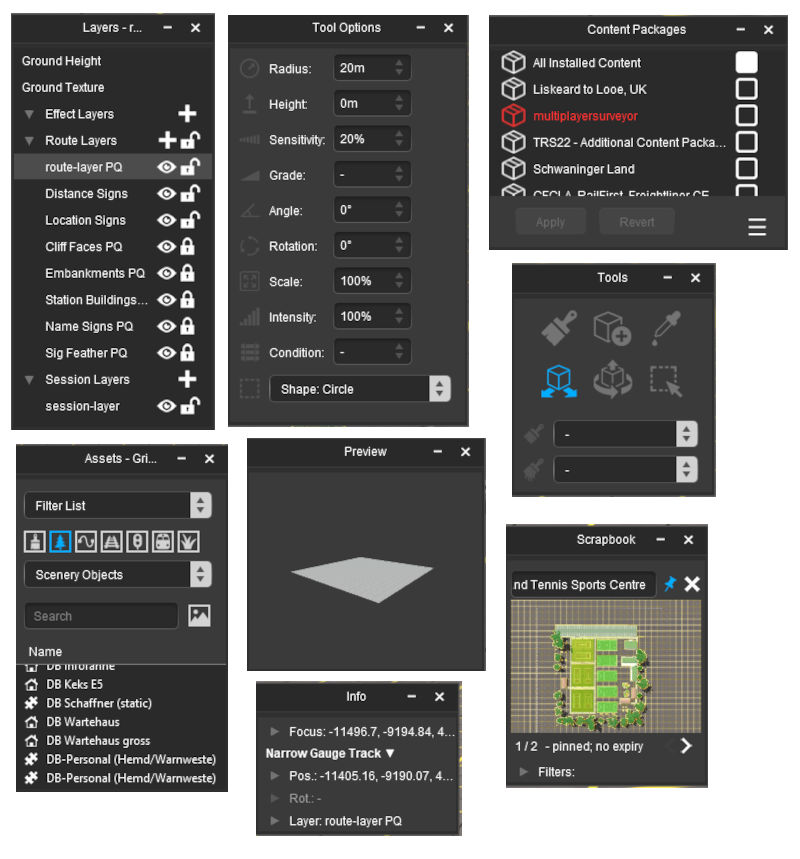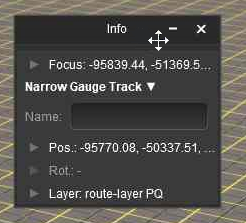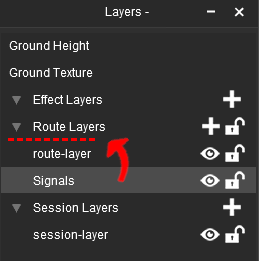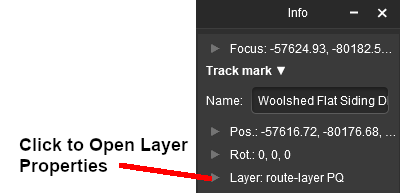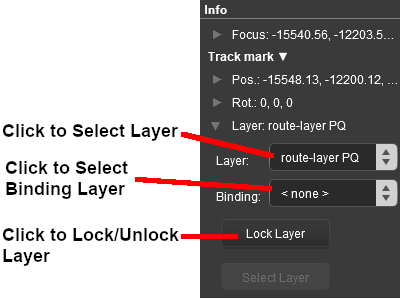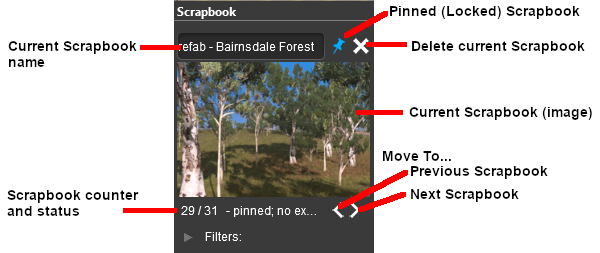How to Use S20 Palettes
m (→The Tools Palette) |
m |
||
| Line 367: | Line 367: | ||
</td> | </td> | ||
</tr> | </tr> | ||
| − | <table> | + | </table> |
<br> | <br> | ||
The '''Info Palette''' will appear as shown in the image below.<br> | The '''Info Palette''' will appear as shown in the image below.<br> | ||
| Line 495: | Line 495: | ||
<tr valign="top"> | <tr valign="top"> | ||
<td width=370>[[image:InfoPaletteMenu_S20.png|link=]]</td> | <td width=370>[[image:InfoPaletteMenu_S20.png|link=]]</td> | ||
| − | <td>The menu options are:- | + | <td width=630>The menu options are:- |
| − | <table> | + | <table width=630> |
| + | <tr valign="top"> | ||
| + | <td width=630 colspan=2> | ||
| + | <table width=630 bgcolor=#ff0000 cellpadding=2> | ||
| + | <tr valign="top"> | ||
| + | <td> | ||
| + | <table width=626 bgcolor=#ffffff cellpadding=2> | ||
<tr valign="top"> | <tr valign="top"> | ||
<td width=200><span style="font-weight: 700; font-size: 15px; color: white; background-color: black;"> Copy </span></td> | <td width=200><span style="font-weight: 700; font-size: 15px; color: white; background-color: black;"> Copy </span></td> | ||
| − | <td> | + | <td><span style="font-weight: 700; font-size: 15px; color: red;">NOT WORKING</span> (a known bug) - this option copies the objects details as text for pasting into a text editor</td> |
| + | </tr> | ||
| + | </table> | ||
| + | </td> | ||
| + | </tr> | ||
| + | </table> | ||
| + | </td> | ||
</tr> | </tr> | ||
<tr valign="top"> | <tr valign="top"> | ||
| − | <td><span style="font-weight: 700; font-size: 15px; color: white; background-color: black;"> Show Asset Details </span></td> | + | <td width=200><span style="font-weight: 700; font-size: 15px; color: white; background-color: black;"> Show Asset Details </span></td> |
<td>opens a new window showing the image and description of the selected object</td> | <td>opens a new window showing the image and description of the selected object</td> | ||
</tr> | </tr> | ||
| Line 741: | Line 753: | ||
</table> | </table> | ||
<br> | <br> | ||
| − | <table width= | + | <table width=1000> |
<tr valign="top"> | <tr valign="top"> | ||
<td width=265>[[image:InfoPaletteLayerDropBoxList_S20.png|link=]]</td> | <td width=265>[[image:InfoPaletteLayerDropBoxList_S20.png|link=]]</td> | ||
| − | <td width= | + | <td width=735> |
<table bgcolor=##ff0000 width=635 cellpadding=2> | <table bgcolor=##ff0000 width=635 cellpadding=2> | ||
<tr valign="top"> | <tr valign="top"> | ||
| Line 758: | Line 770: | ||
</table> | </table> | ||
<br> | <br> | ||
| − | <table bgcolor=#000000 width= | + | <table bgcolor=#000000 width=735 cellpadding=2> |
<tr valign="top"> | <tr valign="top"> | ||
<td> | <td> | ||
| − | <table bgcolor=#ffffff width= | + | <table bgcolor=#ffffff width=731 cellpadding=2> |
<tr valign="top"> | <tr valign="top"> | ||
<td colspan=2><span style="font-weight: 700; font-size: 15px;;">Steps:</span> To change the assigned layer of an object or group of objects:-</td> | <td colspan=2><span style="font-weight: 700; font-size: 15px;;">Steps:</span> To change the assigned layer of an object or group of objects:-</td> | ||
| Line 799: | Line 811: | ||
<br> | <br> | ||
| − | <table bgcolor=#000000 width= | + | <table bgcolor=#000000 width=1000 cellpadding=2> |
<tr valign="top"> | <tr valign="top"> | ||
<td> | <td> | ||
| − | <table bgcolor=#ffffff width= | + | <table bgcolor=#ffffff width=996 cellpadding=2> |
<tr valign="top"> | <tr valign="top"> | ||
<td colspan=2>[[image:Ablue.png|link=]] '''If the <span style="font-weight: 700; font-size: 15px; color: white; background-color: black;"> Select Layer </span> button is greyed out'''</td> | <td colspan=2>[[image:Ablue.png|link=]] '''If the <span style="font-weight: 700; font-size: 15px; color: white; background-color: black;"> Select Layer </span> button is greyed out'''</td> | ||
| Line 847: | Line 859: | ||
<br> | <br> | ||
| − | <table bgcolor=#000000 width= | + | <table bgcolor=#000000 width=1000 cellpadding=2> |
<tr valign="top"> | <tr valign="top"> | ||
<td> | <td> | ||
| − | <table bgcolor=#ffffff width= | + | <table bgcolor=#ffffff width=996 cellpadding=2> |
<tr valign="top"> | <tr valign="top"> | ||
<td colspan=2>Some examples of using the '''Binding Layer''':-<br> | <td colspan=2>Some examples of using the '''Binding Layer''':-<br> | ||
| Line 881: | Line 893: | ||
</table> | </table> | ||
<br> | <br> | ||
| − | <table width= | + | <table width=1000> |
<tr valign="top"> | <tr valign="top"> | ||
<td width=265>[[image:InfoPaletteBindingDropBox_S20.png|link=]]</td> | <td width=265>[[image:InfoPaletteBindingDropBox_S20.png|link=]]</td> | ||
| − | <td width= | + | <td width=735> |
<table bgcolor=#000000 width=635 cellpadding=2> | <table bgcolor=#000000 width=635 cellpadding=2> | ||
<tr valign="top"> | <tr valign="top"> | ||
| Line 915: | Line 927: | ||
</table> | </table> | ||
<br> | <br> | ||
| − | <table width= | + | <table width=1000> |
<tr valign="top"> | <tr valign="top"> | ||
<td colspan=2>As an example, the image below shows what you will see for a single object that has had:-</td> | <td colspan=2>As an example, the image below shows what you will see for a single object that has had:-</td> | ||
| Line 922: | Line 934: | ||
<td width=210>[[image:InfoPaletteLayerSetBindingSet_S20.png|link=]]</td> | <td width=210>[[image:InfoPaletteLayerSetBindingSet_S20.png|link=]]</td> | ||
<td> | <td> | ||
| − | <table width= | + | <table width=790> |
<tr valign="top"> | <tr valign="top"> | ||
<td width=10>[[image:DotPoint.JPG|10px|link=]]</td> | <td width=10>[[image:DotPoint.JPG|10px|link=]]</td> | ||
| Line 1,005: | Line 1,017: | ||
<br> | <br> | ||
| − | <table width= | + | <table width=1000 bgcolor=#000000 cellpadding=2> |
<tr valign="top"> | <tr valign="top"> | ||
| + | <td> | ||
| + | <table width=996 bgcolor=#ffffff> | ||
| + | <tr> | ||
<td>Various brush tools make use of the '''Tool Options Palette''', the '''Assets Palette''', the '''Info Palette''', the '''Layers Palette''' and the '''Scrapbook Palette'''. If a palette required by one of the brush tools is not visible on the screen then refer to [[image:PageLink.PNG|link=]] '''[[#Hiding and Showing Palettes|Hiding and Showing Palettes]]''' at the top of this document. | <td>Various brush tools make use of the '''Tool Options Palette''', the '''Assets Palette''', the '''Info Palette''', the '''Layers Palette''' and the '''Scrapbook Palette'''. If a palette required by one of the brush tools is not visible on the screen then refer to [[image:PageLink.PNG|link=]] '''[[#Hiding and Showing Palettes|Hiding and Showing Palettes]]''' at the top of this document. | ||
| + | </td> | ||
| + | </tr> | ||
| + | </table> | ||
</td> | </td> | ||
</tr> | </tr> | ||
| Line 1,023: | Line 1,041: | ||
<br> | <br> | ||
| − | <table width= | + | <table width=1000> |
<tr valign="top"> | <tr valign="top"> | ||
<td width=200>[[image:BrushTools_S20.png|link=|alt=Brush Tools]]</td> | <td width=200>[[image:BrushTools_S20.png|link=|alt=Brush Tools]]</td> | ||
<td> | <td> | ||
| − | <table width= | + | <table width=800> |
<tr valign="top"> | <tr valign="top"> | ||
<td colspan=3>The '''Brush Tool''' has two drop down menu lists.<br> | <td colspan=3>The '''Brush Tool''' has two drop down menu lists.<br> | ||
| Line 1,088: | Line 1,106: | ||
<table width=996 bgcolor=#ffffff cellpadding=2> | <table width=996 bgcolor=#ffffff cellpadding=2> | ||
<tr> | <tr> | ||
| − | <td>For | + | <td>For more detailed information on using the '''Brush Tool''' see the '''Trainz Wiki''' page [[image:WikiLink.PNG|link=]] '''[[How_to_Use_S20_Tools#The Brush Tool|How to Use the Surveyor 2.0 Tools]]'''</td> |
</tr> | </tr> | ||
</table> | </table> | ||
| Line 1,106: | Line 1,124: | ||
</table> | </table> | ||
<br> | <br> | ||
| − | <table width= | + | <table width=1000> |
<tr valign="top"> | <tr valign="top"> | ||
<td width=200>[[image:PlacementTools_S20.png|link=|alt=Placement Tools]]</td> | <td width=200>[[image:PlacementTools_S20.png|link=|alt=Placement Tools]]</td> | ||
<td> | <td> | ||
| − | <table> | + | <table width=800> |
<tr valign="top"> | <tr valign="top"> | ||
<td colspan=5>The '''Placement Tool''' places all types of objects except textures and effect layers</td> | <td colspan=5>The '''Placement Tool''' places all types of objects except textures and effect layers</td> | ||
| Line 1,143: | Line 1,161: | ||
<table width=996 bgcolor=#ffffff cellpadding=2> | <table width=996 bgcolor=#ffffff cellpadding=2> | ||
<tr> | <tr> | ||
| − | <td>For detailed information on using the '''Placement Tool''' see the '''Trainz Wiki''' page [[image:WikiLink.PNG|link=]] '''[[How_to_Use_S20_Tools#The Placement Tool|How to Use the Surveyor 2.0 Tools]]'''</td> | + | <td>For more detailed information on using the '''Placement Tool''' see the '''Trainz Wiki''' page [[image:WikiLink.PNG|link=]] '''[[How_to_Use_S20_Tools#The Placement Tool|How to Use the Surveyor 2.0 Tools]]'''</td> |
</tr> | </tr> | ||
</table> | </table> | ||
| Line 1,187: | Line 1,205: | ||
<table width=996 bgcolor=#ffffff cellpadding=2> | <table width=996 bgcolor=#ffffff cellpadding=2> | ||
<tr> | <tr> | ||
| − | <td>For detailed information on using the '''Eyedropper Tool''' see the '''Trainz Wiki''' page [[image:WikiLink.PNG|link=]] '''[[How_to_Use_S20_Tools#The Eyedropper Tool|How to Use the Surveyor 2.0 Tools]]'''</td> | + | <td>For more detailed information on using the '''Eyedropper Tool''' see the '''Trainz Wiki''' page [[image:WikiLink.PNG|link=]] '''[[How_to_Use_S20_Tools#The Eyedropper Tool|How to Use the Surveyor 2.0 Tools]]'''</td> |
</tr> | </tr> | ||
</table> | </table> | ||
| Line 1,239: | Line 1,257: | ||
<table width=996 bgcolor=#ffffff cellpadding=2> | <table width=996 bgcolor=#ffffff cellpadding=2> | ||
<tr> | <tr> | ||
| − | <td>For detailed information on using the '''Free Move Tool''' see the '''Trainz Wiki''' page [[image:WikiLink.PNG|link=]] '''[[How_to_Use_S20_Tools#The Free Move Tool|How to Use the Surveyor 2.0 Tools]]'''</td> | + | <td>For more detailed information on using the '''Free Move Tool''' see the '''Trainz Wiki''' page [[image:WikiLink.PNG|link=]] '''[[How_to_Use_S20_Tools#The Free Move Tool|How to Use the Surveyor 2.0 Tools]]'''</td> |
</tr> | </tr> | ||
</table> | </table> | ||
| Line 1,308: | Line 1,326: | ||
<table width=996 bgcolor=#ffffff cellpadding=2> | <table width=996 bgcolor=#ffffff cellpadding=2> | ||
<tr> | <tr> | ||
| − | <td>For detailed information on using the '''Fine Adjustment Tool''' see the '''Trainz Wiki''' page [[image:WikiLink.PNG|link=]] '''[[How_to_Use_S20_Tools#The Fine Adjustment Tool|How to Use the Surveyor 2.0 Tools]]'''</td> | + | <td>For more detailed information on using the '''Fine Adjustment Tool''' see the '''Trainz Wiki''' page [[image:WikiLink.PNG|link=]] '''[[How_to_Use_S20_Tools#The Fine Adjustment Tool|How to Use the Surveyor 2.0 Tools]]'''</td> |
</tr> | </tr> | ||
</table> | </table> | ||
| Line 1,346: | Line 1,364: | ||
<table width=996 bgcolor=#ffffff cellpadding=2> | <table width=996 bgcolor=#ffffff cellpadding=2> | ||
<tr> | <tr> | ||
| − | <td>For detailed information on using the '''Marquee Tool''' see the '''Trainz Wiki''' page [[image:WikiLink.PNG|link=]] '''[[How_to_Use_S20_Tools#The Marquee Tool|How to Use the Surveyor 2.0 Tools]]'''</td> | + | <td>For more detailed information on using the '''Marquee Tool''' see the '''Trainz Wiki''' page [[image:WikiLink.PNG|link=]] '''[[How_to_Use_S20_Tools#The Marquee Tool|How to Use the Surveyor 2.0 Tools]]'''</td> |
</tr> | </tr> | ||
</table> | </table> | ||
Revision as of 09:41, 1 March 2023
The information in this Wiki Page applies to Surveyor 2.0 (S20) as found in Trainz Plus. The original refernce material for this document can be found at Surveyor 2.0 Overview
|
This document is still under construction
|
The Surveyor 2.0 World
When you start Trainz in Survayor 2.0 the world presented will look something like the following image, but what you actually see can be highly customised to your own preferences.
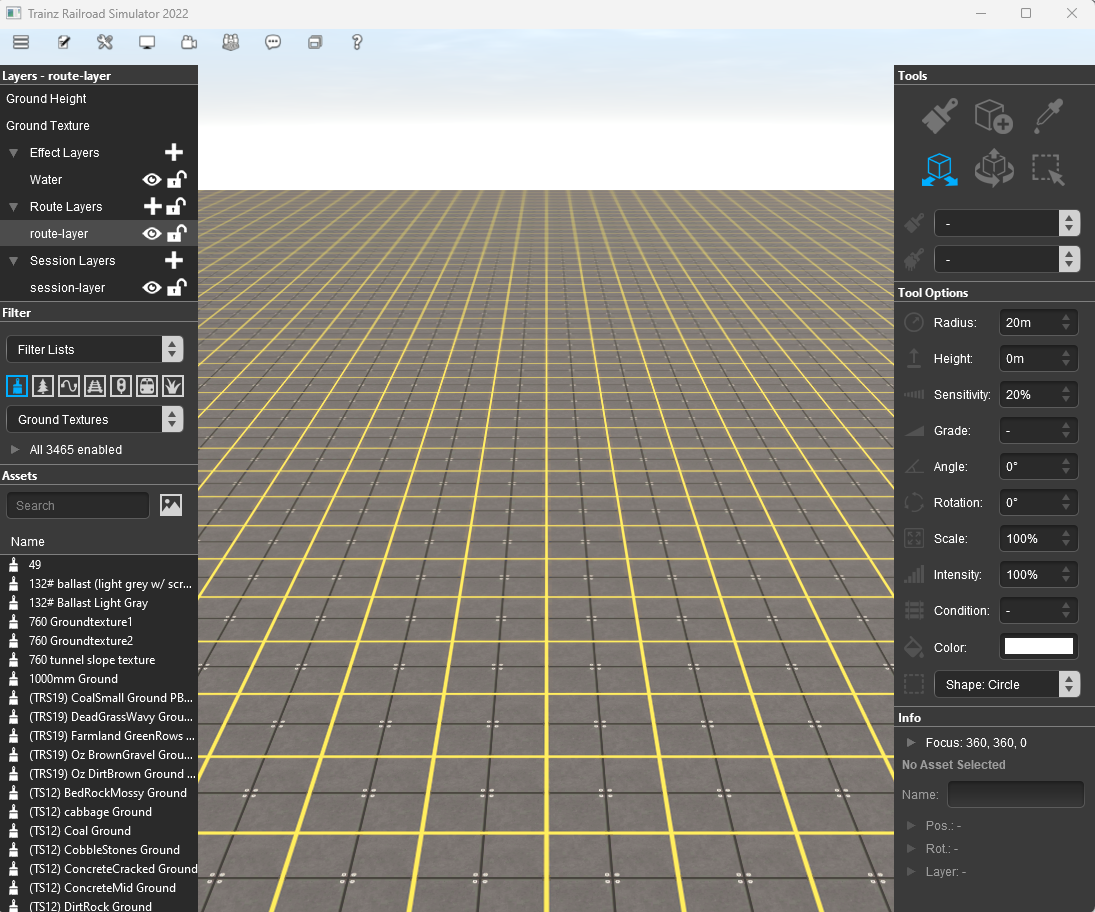
The grey boxes on the left and right of the screen are Palettes, where selections can be made, information displayed and controls set.
|
|
||||||||||||||||||||||
Hiding and Showing Palettes
Palettes are hidden and revealed using the Window Menu on the top Surveyor Menu bar.
The 5 visible and 3 hidden Palettes in the screenshot image shown above have had their visibility set by:-
|
|
||||||||||||||
Docking and Undocking Palettes
To Undock a palette from its normal position on either side of the screen:-
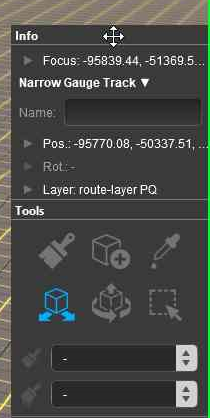 |
|
||||||||||||
To reverse the process and dock a palette:-
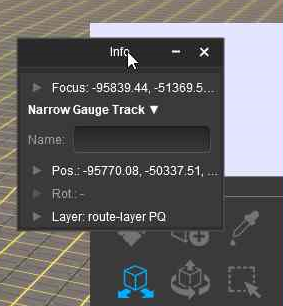 |
|
||||||||||||||||||||
Resizing Palettes
Only palettes that are undocked can be resized.
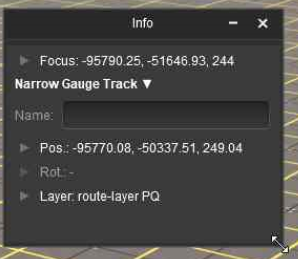 |
|
||||||||||||||||||
Closing Palettes
| This is the same as hiding a palette. Once a palette has been undocked it can be closed (hidden) by a Left click on its Close |
The Info Palette
|
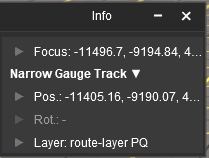 |
|
||||||||||
The Info Palette will appear as shown in the image below.
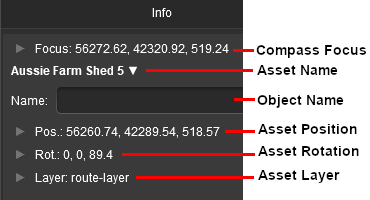 |
Each of the small arrowhead icons will open the palette to display more information and some controls. |
|
||||||||||||||||
Focus Info and Controls
The Focus shows the current position and height of the Cursor object. Open up the Focus by Left clicking on its arrowhead icon.
|
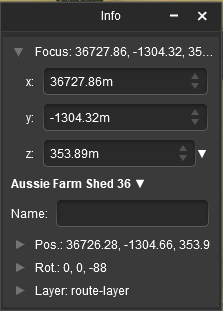 |
|
Next to the Z co-ordinate is a small white down arrowhead. Left click on the arrow to open its menu.
 |
There is only one item in the sub-menu. Use Height for Brush Left click on the option to copy the current cursor height (Z) value from the Info Palette to the Tool Options Palette Height entry. |
Asset Name Menu
You must have an object (or objects) selected for a name to be shown and the menu to be available.
| If the selected objects are different then a count of the additional objects will be added. The (+2) shown in the object name in the image on the left indicates that "2" additional different objects are in the group of selected objects. The name and position data shown will be for the last selected object. |
Next to the objects name is a small white Down Arrowhead. Left click on the arrowhead to open its menu.
 |
The menu options are:-
|
|||||||||||||||
Position Info and Controls
You must have an object (or objects) selected for the position data to be shown and edited. Open up the position data by Left clicking on its Pos: arrowhead icon.
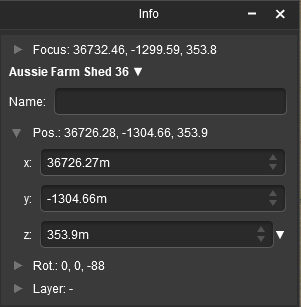 |
The position of the selected object (or the last object if more than one is selected) is shown in the X, Y and Z text boxes. These values can be edited to move the object or objects to a new position but CARE will be needed.
|
Next to the Z co-ordinate is a small white down arrowhead. Left click on the arrow to open its menu.
 |
There is only one item in the sub-menu. Use Height for Brush Left click on the option to copy the height (Z) value for the selected object from the Info Palette to the Tool Options Palette Height entry. |
Rotation Info and Controls
You must have an object (or objects) selected for the rotation data to be shown and edited. Open up the rotation data by Left clicking on its Rot: arrowhead icon.
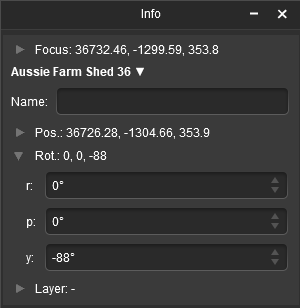 |
The rotational orientation of the selected object (or the last object if more than one is selected) is shown in the R, P and Y text boxes. These values can be edited to rotate the object or objects in 3D space BUT not all objects can be rotated in certain directions. On the right of each box is a pair of Up/Down controls. Left Click and Drag up or down on these to adjust the rotation angle in increments of 1°. |
|
||||||||||||||||||||
Layer Info and Controls
You must have an object (or objects) selected for the layer data to be shown and edited. Open up the layer data by Left clicking on its Layer: arrowhead icon.
|
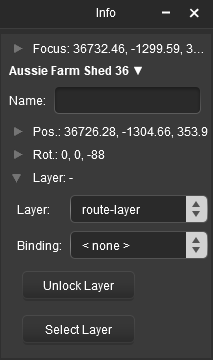 |
This will show the:-
|
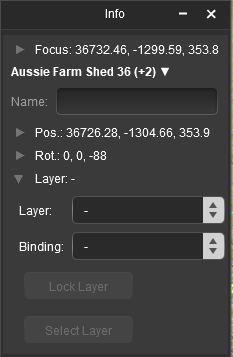 |
If multiple objects from different layers have been selected then no layer name will be shown in the Layer and Binding boxes. Instead they will be left "blank" as shown in the image on the left. Both boxes can still be opened to assign layers to objects. |
Assigning Objects to a Different Layer
A selected object or group of selected objects can be assigned to a different layer. If multiple objects have been selected then they do not have to all be in the same layer.
|
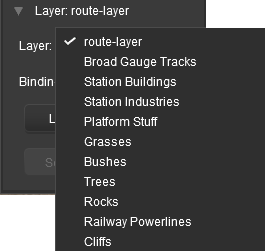 |
|
||||||||||||||
| Once a target layer has been selected then the Select Layer button, which sets the Active Layer, may become active. The Active Layer is the layer used by the Placement Tool when objects are added to a route (or session). This button gives you the opportunity to set the Active Layer to the same layer that you just used to assign to an object. Its use is optional. |
|
||||||||
Assigning Objects to a Binding Layer
| The Binding Layer, or Bound Layer as it is also called, is a tool used in the development of a route or session. It allows you to temporarily assign an object to a second layer while it is still in its original layer. The object will then take on the properties (Locked/Unlocked, Hidden/Visible) of both layers. |
| So if the original layer or the binding layer of an object is:- | |
| LOCKED then the object will be LOCKED | |
| HIDDEN then the object will be HIDDEN | |
|
||||||||||||
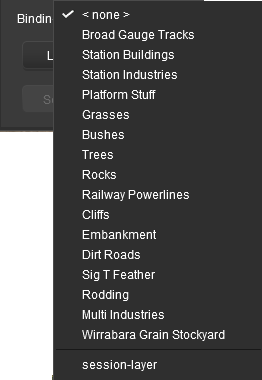 |
|
|||||||||||
| As an example, the image below shows what you will see for a single object that has had:- | |||||||||
 |
|
||||||||
 |
More information on creating, editing and using Layers can be found on the Trainz Wiki at:- |
The Tools Palette
|
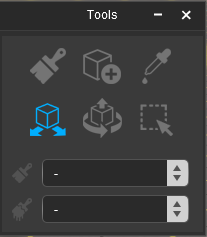 |
|
 |
The Context Tool is attached as an icon to a selected or newly placed object. The icon and its Context menu will vary according to the type of object. |
|
The Brush Tool
| Keyboard Shortcut: W | The Brush Tool "paints" the ground height, ground textures, effect layers and scrapbook scenes in a route |
 |
|
|||||||||||||||||||
| The Brush Targets Ground Height , Scrapbook Data and Effect Layers have a second drop down menu that controls the Brush Action. |
|
The Placement Tool
| Keyboard Shortcut: E | The Placement Tool adds objects to a route |
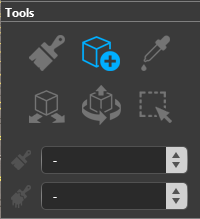 |
|
||||||||||||||||||||
|
The Eyedropper Tool
| Keyboard Shortcut: R | The Eyedropper Tool identifies and selects objects in a route |
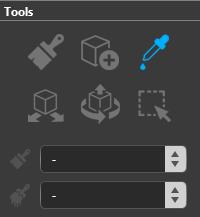 |
|
|
The Free Move Tool
| Keyboard Shortcut: S | The Free Move Tool moves objects around a route |
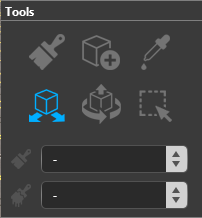 |
|
|
The Fine Adjustment Tool
| Keyboard Shortcut: D | The Fine Adjustment Tool makes 3D adjustments (XYZ position and rotations) to objects in a route |
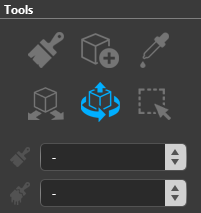 |
|
||||||||||||||||
|
The Marquee Tool
| Keyboard Shortcut: F | The Marquee Tool selects the content in areas of a route, creates and deletes baseboards and sets their properties. It can also be used in creating Scrapbooks |
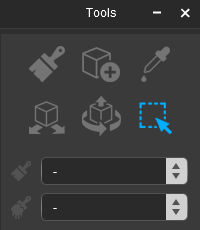 |
|
|
The Tool Options Palette
| This palette is used by various tools to set controls and parameters. For a detailed description of all the options presented by the Tools Palette for the different tools, see the Trainz Wiki page |
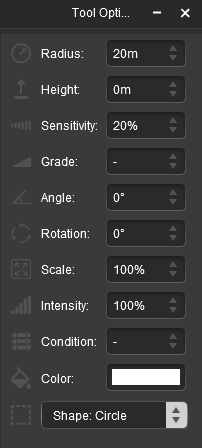 |
All the Tool Options controls and settings are shown in the image on the left. The controls are shown as being "inactive". Some examples of when the controls will become active are:-
|
|||||||||||||||||||||||
A Track Spline Object is selected with the Free Move Tool or the Fine Adjustment Tool then certain controls that will affect the placement of the track will become active.
|
||||||||||||||||||
|
|||||||||||||||||||||||||||||||
Scrapbook Brush 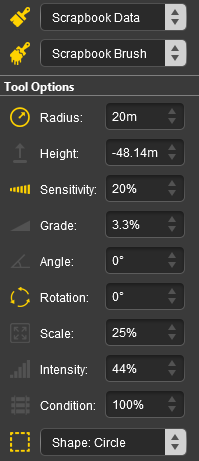 |
Scrapbook Clone  |
|
|||||||||||||||||||||||||||||
The Assets Palette
| This palette is used by various tools and other palettes to select and identify assets and objects. It includes a filter function to narrow down the search and selection process. |
The Layers Palette
| This palette is used to manage layers, both object (route and session) and effect (TurfFX, clutter and water) layers. It can create, rename, delete, move, hide/show and lock/unlock layers and set the Active Layer. |
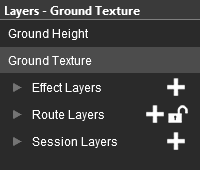 |
The Layers Palette will show all the layers in their groups (Effect, Route and Session) plus the Ground Height and Ground Textures special "layers". In the image on the left all the layer groups have been minimised (the arrowhead symbol to the left of each group name is pointing to the right).
|
Lock the Route Layer Group
| All the Route Layers can be locked against accidental alteration. |
The Route Layers group has a open padlock icon next to its name - shown as ![]() (unlocked).
(unlocked).
|
||||||
Open a Layer Group
To the left of each group name is a small arrowhead pointing to the right. Left click on the arrowhead to open up the group.
 |
The image on the left shows that the Session Layers is open and its individual layers are now displayed. To close or minimise the group Left click on the arrowhead again. The image shows that the Session Layers contains 3 individual layers:-
|
Add a New Layer
You cannot create new layer groups but you can add new layers to a existing group.
Each layer group has a ![]() icon next to its name. Left click on the icon to add and name a new layer to that group. If you are adding a new Effect Layer then you will also have to identify the type of effect - TurfFX, Clutter or Water.
icon next to its name. Left click on the icon to add and name a new layer to that group. If you are adding a new Effect Layer then you will also have to identify the type of effect - TurfFX, Clutter or Water.
Renaming a Layer
 |
Right click on a layer name and select Rename Layer.. from the popup menu. You will be asked to enter a new name for the layer. |
Deleting a Layer
 |
|
|||||||||||||||
Moving a Layer
Layers can be individually moved up and down within the same layer group or between the Route Layers and the Session Layers groups.
|
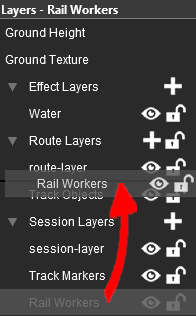 Moving the Rail Workers layer up one level |
|
|||||||||||||||
|
||||||||||||||||||||||||
Merging a Layer
 |
Right click on a layer name and select Merge Layer Up from the popup menu.
|
Hiding Layers
Each individual layer has an Eye icon that controls the state (visible or hidden) of that layer. Left click on the icon to toggle its state between visible and hidden.
If the Eye icon is:-
 open then layer is visible in both Surveyor and Driver
open then layer is visible in both Surveyor and Driver
 closed then layer is hidden in both Surveyor and Driver
closed then layer is hidden in both Surveyor and Driver
Locking Layers
Each individual layer has a Padlock icon that controls the state (locked or unlocked) of that layer. Left click on the icon to toggle its state between locked and unlocked.
If the Padlock icon is:-
 open then the layer is unlocked and can be edited
open then the layer is unlocked and can be edited
 closed then the layer is locked and cannot be edited
closed then the layer is locked and cannot be edited
|
Setting the Active Layer
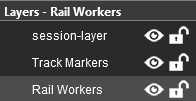 |
The Active Layer is the layer where new objects will be automatically added when using the Placement Tool. The active layer is shown in the palette with its name on a blue background. In the image on the left the Rail Workers layer is the current Active Layer. The name of the current Active Layer is also shown in the Layer Palette Title Bar. To set a new Active Layer, Left click on a layer name. |
Move an Object to a New Layer
| The Info Palette will show the layer assigned to the currently selected object. An object is selected by using the Free Move Tool (the S key) or the Fine Adjustment Tool (the D key) found in the Tools Palette. |
|||||||||||||
|
|
|
||||||||||||
The Scrapbook Palette
|
| This palette manages the Scrapbooks that you have created yourself, installed from other sources (such as the DLS) or came installed with Trainz. It also controls which parts of a scrapbook are pasted or painted into a route. |
|
|
||||||||||||||||||||||||||||||||||
|
|
|||||||||||||||
Creating a New Scrapbook
|
|||||||||||
|
When a new Scrapbook is created by a Cut or Copy , it will appear in the Scrapbook palette with some basic details.
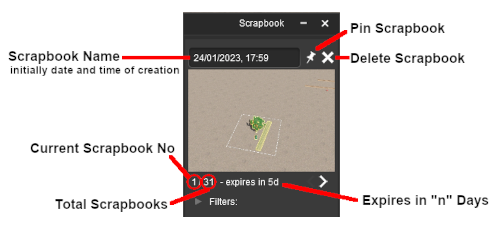 |
|
|||||||||||||||
|
|
|
 |
||||||||||
Once a scrapbook has been Pinned it becomes an asset and will appear in Content Manager

The scrapbook can be uploaded to the DLS and saved as a CDP file.
|
Painting or Pasting a Scrapbook
Existing Scrapbooks can be painted into a route using the Brush Tool (see the Trainz Wiki page How to Use the Surveyor 2.0 Tools) or Pasted into a route.
|
||||||||
Left click on the arrowhead next to the Filters: label below the scrapbook image to open the scrapbook filter controls. These filters will control which elements in the scrapbook will be added to the route and how thay will be added.
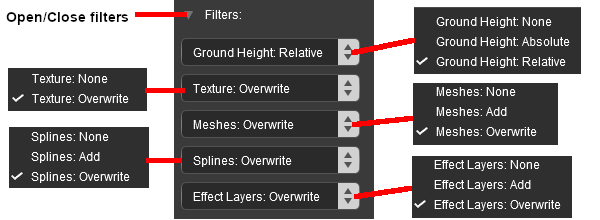
|
|
||||||||||||||||||||||||||||||||||||||||||||||||||||||||||||||
The Preview Palette
| This palette gives a rotating 3D view of a selected asset |
The Packages Palette
| This palette |
Trainz Wiki
 |
More Tutorials and Guides to Using Trainz |
This page was created by Trainz user pware in February 2023 and was last updated as shown below.
